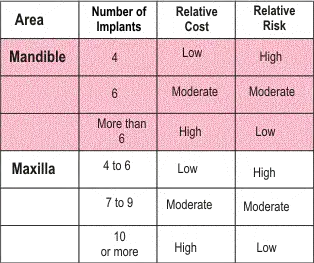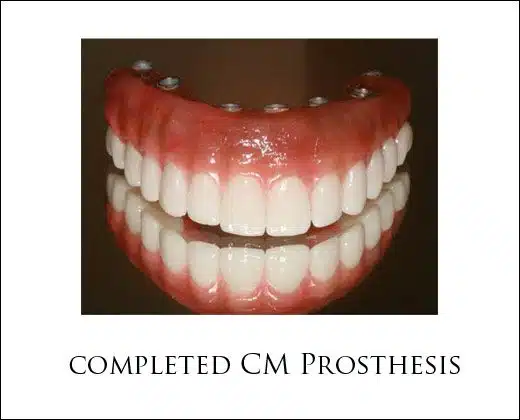What types of prostheses are used with dental implants? Here are some of the dental implant prosthesis options available at Pi Dental Center.
Menu for Full Arch Fixed Dental Implant Restorations
Full Arch Fixed Implant Restoration Choices:
AvaDent® Fully Milled Prosthesis:
A custom computer milled framework of titanium is used to provide optimal strength and hygiene access for an acrylic tooth prosthesis. The acrylic teeth are milled from a single piece of acrylic for a strong, durable and esthetic restoration. This prosthesis is generally recommended for the lower jaw.
Porcelain Fused to Metal Implant Restoration:
A custom designed metal alloy framework is casted from a wax pattern. Porcelain is custom baked to the framework to provide excellent esthetics and hygiene access. There is good resistance to wear. This is a superior restoration for a full upper arch or partial segment and has a long track record of success.
CM Prosthesis:
A solid titanium infrastructure uniquely designed to receive individual esthetically customized zirconia or lithium disilicate ceramic crowns. This restoration is the most technologically and esthetically advanced form of fixed prosthodontic full arch rehabilitation and is the epitome of biomedical engineering using CAD/CAM technology to provide patients with precision implant-supported functional replication of the natural dentition.
|
Final Restorations
|
Cost
|
Cost
|
Esthetics
|
Relative Risk
|
Tooth Wear Rates
|
|
AvaDent® Fully Milled Prosthesis
|
$$
|
Moderate
|
Moderate
|
Low
|
Moderate
|
|
Porcelain Fused to Metal Implant Restoration
|
$$$
|
High
|
High
|
Low
|
Low
|
|
CM Prosthesis
|
$$$
|
High
|
High
|
Low
|
Low
|
Definition of Risk for Implant Supported Prostheses
High Risk: If a bare minimum number of implants are placed, and the bone fails to integrate with one or more implants, additional surgical procedures will be necessary at an additional cost to the patient in order to provide adequate support for the restoration. There is a high risk of future complications due to lack of bio-mechanical support.
Moderate Risk: If the bone fails to integrate with one or more implants, then additional surgical procedures may be indicated at an additional cost to the patient in order to provide adequate support for the restoration. There is a moderate risk of future complications. In some circumstances, implant loss may require prosthesis revision (shortening).
Low Risk: If the bone fails to integrate with one or more implants, there is little chance of the need for an additional surgical procedure. There is a low risk for future complications.
Continuing Care
It should be noted that maintenance is a very important aspect of dental implant treatment. Oral hygiene cleanings on a 3 to 6 month schedule, periodic screw checks or screw replacement and adjustments are recommended. In Addition, new veneering materials or a whole new prosthesis may be necessary over time due to normal wear and tear and ongoing function. Please ask for details about continued maintenance.
Definitions of Risk to Prosthesis

Moderate Risk: There is a moderate probability that complications could occur which may require intraoral or laboratory repairs of veneering materials, supporting structure or components.
Low Risk: There is a low probability that complications could occur which may require intraoral or laboratory repairs of veneering, supporting structure or components.
Bruxing and Clenching: The risk of complications to the prosthesis are not only related to the materials used, but also to the type of forces generated on those materials. Patients with parafunctional habits including, but not limited to bruxing and clenching, are highly susceptible to complications.
While there is no way to eliminate these habits, fabrication and use of an occlusal guard will provide protection during the hours it is worn. Acrylic fractures are repairable, however, porcelain fractures are not. Any repairs, revisions or alterations will require additional charges. Porcelain fractures may require additional procedures to resolve functional and/or esthetic concerns. Food may collect under any implant restoration. Frequent irrigation with diligent home care and regular oral hygiene cleaning by a dental hygienist specializing in dental implant treatment will prevent soft and hard tissue complications. Temporary filling material used to cover the screw access holes may become loose. This presents no danger to the restoration. Some patients prefer to have the access holes filled with composite. This is undoubtedly a more permanent material but it is also a more difficult to remove, should the need arise.
Having an in-house ceramist clearly allows us to achieve superior esthetic results. An in-house lab technician is a luxury that few other dental offices have. Learn about the Master Ceramist.
Visit the CM Prosthetics web site.
